Unexplodedcow
Member
- Joined
- May 23, 2011
- Posts
- 52
- Reaction score
- 16
UMI called me back today, and we're going with some custom-fit chassis bushings and new ball ends at the axle end. The MM relocation brackets are going to be removed.
Good call.UMI called me back today, and we're going with some custom-fit chassis bushings and new ball ends at the axle end. The MM relocation brackets are going to be removed.
Even if you chock the front tires (front and back) and at least the rear tire on the side you're working on (ditto), expect to end up with a little misalignment between the holes in the bracket and the holes through the center of the bushing or spherical joint.If I back the car up on ramps, and start the removal, will the axle-housing and chassis slip out of alignment so as to make instilling the new part a challenge?
Even if you chock the front tires (front and back) and at least the rear tire on the side you're working on (ditto), expect to end up with a little misalignment between the holes in the bracket and the holes through the center of the bushing or spherical joint.
Mount the chassis-side of the LCA first. and use a tapered drift pin to wiggle the axle-side pieces into alignment from one side while you install the bolt from the other. Worst case, you might have to relax the position of one of the rear wheel chocks.
Norm
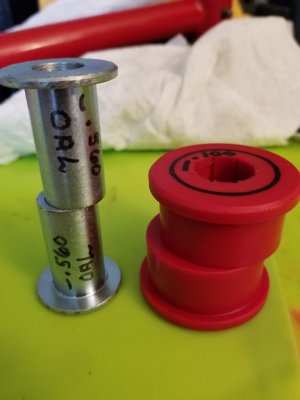
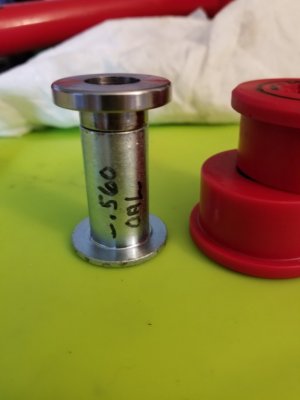
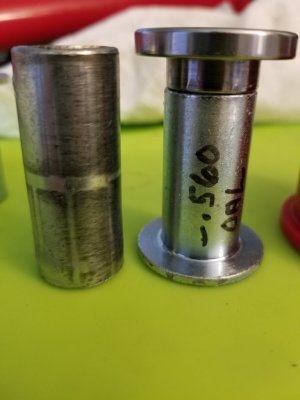
This doesn't seem to be a problem. I've been shaving (in most cases tapering and in some cases making yet another mod to the poly) off and on for over 20 years without adverse effects showing up even after 8 or more years in service.They are about 0.560" too long on both ends, and would need to be cut down, while the bushings would need a 0.1" deep countersink to fit the flange of the sleeves. The thought came that the bushing flanges are 0.2" thick, and taking 0.1" is easier, with the sleeve flange then being responsible for preventing bushing movement. I don't know if this would be useful or cause problems in the future, as the walls of the bushings would then have slight clearance against the torque box walls.
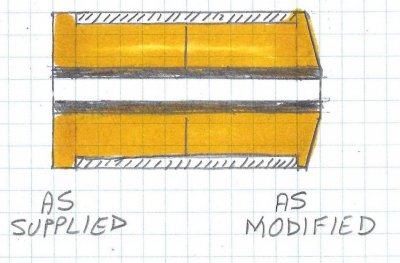
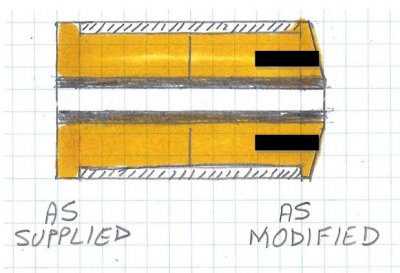
In addition to what Norm suggested here, you can use a cargo tie down ratchet strap to hold the rear axle in place loaded while on ramps to assist in changing out the LCA's. I've used these on mine & if you do need to readjust to center holes just reset the strap tension. I set the strap tension until the bolts come loose in the arms then pull out, drop em then install the new ones as Norm has laid out.Thanks. Exactly the advice I was looking for.
+1 on this. I had to disconnect the LCA to install my 1piece driveshaft. Used the ratchet strap to pull it back into position once it was in.In addition to what Norm suggested here, you can use a cargo tie down ratchet strap to hold the rear axle in place loaded while on ramps to assist in changing out the LCA's. I've used these on mine & if you do need to readjust to center holes just reset the strap tension. I set the strap tension until the bolts come loose in the arms then pull out, drop em then install the new ones as Norm has laid out.
Just another method to use if you have the tool on hand.
Are you absolutely sure this clunk is from the control arms?
Im having trouble with the consistency of it returning.
Sounds similar to my issue with the amount of new hardware and parts. I let mine go for a while, which resulted in hogged-out holes, mostly in the chassis end, and I had to put in stepped weld-washers to fix that problem. At the time it was definitely torque loss due to things compressing, but I've basically resolved it, yet the exact same clunk remains. All that's left is the shocks.This sounds almost exactly what I've been going through with my car. I've removed and retorqued everything so many times in tired of doing it. I've just lived with the clunks going down my drive and road.
Two upper arms, two pan hard bars, three different relocation brackets, countless different types of lock washers and locking nuts, loctite, etc. Poly upper bushing on housing, poly sway bar bushings, countless greasings. I resized all the bolts so they fit tighter in the holes than the stock bolts. Usually meant going up one size to a fractional bolt instead of metric. Clunks always return.
I have steeda billet lca, and I think either a bmr or upr upper, can't remember.
Every time I think I've found the problem, it isn't it. I just keep telling my wife, when it finally breaks, ill fix it. Lol
If you back off the gas in gear, and then punch it again, do you get an almighty clack? I do. It's not like normal gear lash or shifting clunk/clack when letting the clutch out too fast.
I was getting this, only it sounded and felt just like excessive gear lash.
After reading this thread, and getting my car ready for a track day last weekend. I decided to check the torque of the LCAs. Sure enough, the passenger side had loosened up quite a bit and now all sounds and vibration is gone.
